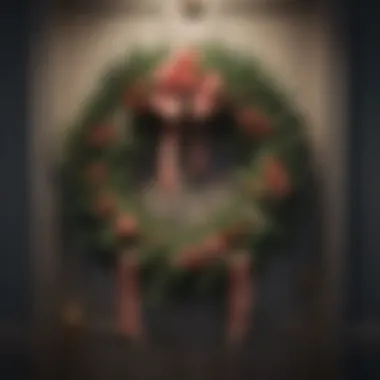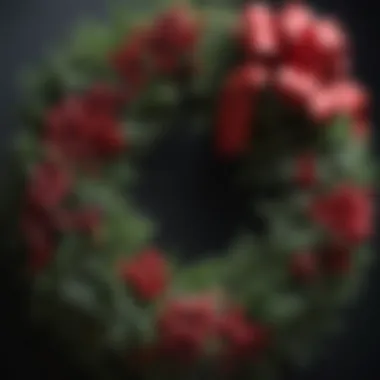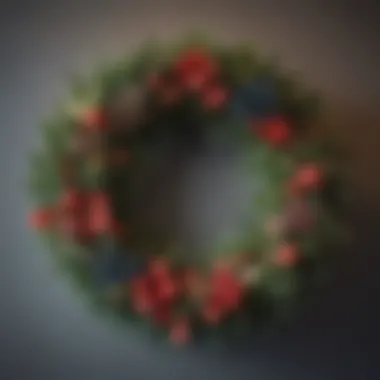Creating Stunning Ribbon Wreaths: A Complete Guide


Intro
Creating ribbon wreaths serves as an inviting way to enhance your living space while showcasing your personal style. This guide delves into the intricacies of ribbon wreath-making, offering insights into materials, design choices, and techniques. Whether you are an experienced DIY enthusiast or a novice just beginning to explore home decor, understanding the essential aspects of this craft will empower you to create stunning pieces tailored to your taste.
Ribbon wreaths are not only versatile in appearance but also provide an enjoyable crafting experience. Engaging in this activity helps develop fine motor skills, boosts creativity, and fosters a sense of accomplishment when you see your final product adorning a door or wall. The goal here is to arm you with the knowledge and confidence needed to craft wreaths that will elevate your home’s ambiance.
Design Inspirations
The design process of ribbon wreaths allows for immense creativity. By merging different styles and utilizing unique color palettes, you unlock endless possibilities to suit your aesthetic preferences.
Trending Styles
Current trends showcase a variety of wreath designs that cater to various tastes and occasions. Here are some styles that are particularly popular:
- Rustic Charm: Wreaths adorned with burlap ribbon and elements from nature provide an organic feel that resonates well in country-style homes.
- Modern Minimalism: Clean lines with single-color ribbons or monochrome themes offer a contemporary touch.
- Whimsical Fun: Mixing playful patterns and bright colors appeals to those wanting a cheerful vibe, especially for children's birthdays or festive celebrations.
Color Palettes
Color selection is crucial in achieving the desired aesthetic for your wreath. Consider these popular palettes:
- Soft Pastels: Light pinks, baby blues, and mint greens create a soothing atmosphere.
- Earthy Tones: Deep browns, rich oranges, and forest greens work well for a more grounded look, especially in the fall.
- Bold Contrasts: Using intense shades like vibrant reds paired with whites or blacks can evoke strong emotional responses, making them visually striking.
"Color is the keyboard, the eyes are the harmonies, the soul is the piano with many strings." – Wassily Kandinsky
These design elements serve to inspire your imagination and invite you to explore the endless combinations available when creating your ribbon wreaths.
Preamble to Ribbon Wreaths
Creating ribbon wreaths is a captivating hobby that brings a touch of personalization to any space. This introduction serves as a foundation for understanding why ribbon wreaths are significant in home decor and how attention to detail can make a profound difference in their aesthetic appeal.
Understanding Wreaths
Wreaths have a long-standing tradition in various cultures. Generally, they symbolize welcome, celebration, or remembrance. Traditionally, they were made from natural materials like branches and flowers. However, modern interpretations, particularly ribbon wreaths, have diversified the possibilities. Ribbon wreaths differ from their traditional counterparts due to their versatility in design, colors, and materials used.
The ability to create a wreath that reflects personal style makes this craft appealing. Unlike other crafts, wreath-making allows for unlimited creativity. You can change designs for seasons or significant events, making each wreath unique and suitable for numerous occasions.
The Appeal of Ribbon Wreaths
The appeal of ribbon wreaths lies in their decorative charm and adaptability. They can enhance any space, whether it be a front door, a wall in your living room, or even a party venue. What sets ribbon wreaths apart is the unique character they bring. Crafting a ribbon wreath allows you to experiment with colors, textures, and patterns without the constraints usually present in other crafts.
Moreover, creating these wreaths is not just about aesthetics. It serves as a therapeutic activity. The process of selecting materials and assembling the wreath can be calming and fulfilling. Furthermore, personalizing a wreath for gifts showcases thoughtfulness and care.
In summary, ribbon wreaths encapsulate the timeless beauty of traditional wreaths while providing a fresh, modern twist. The subsequent sections will unpack essential materials, techniques, and innovative design ideas empowering readers to explore this fulfilling craft.
Essential Materials for Making Ribbon Wreaths
Creating a ribbon wreath begins with selecting the right materials. The essential materials will greatly influence your wreath's overall look, durability, and ease of assembly. Understanding each element helps in making informed choices that suit your design preferences. By investing in quality supplies, you can ensure your dedicated effort leads to a visually appealing and lasting decor piece. The materials dictate the aesthetic quality and strength of the wreath, underlining their importance in the crafting process.
Types of Ribbon
Wire-edged Ribbon
Wire-edged ribbon serves as a foundational choice in wreath making. This type of ribbon features a wire stitched along its edges, allowing it to maintain shape when crafted into loops or bows. The key characteristic of wire-edged ribbon is its versatility. It lends itself to various design styles, from formal to whimsical. This feature makes wire-edged ribbon a popular selection; it holds its form, providing a finished look that other ribbons might struggle to achieve. On the downside, it can be slightly heavier than other ribbon types, which may influence the overall balance of your wreath.
Satin Ribbon
Satin ribbon introduces a touch of elegance to any wreath. The unique luster of satin creates an eye-catching shine that can elevate your design. Its smooth texture enhances the overall aesthetic, making it a favored choice for formal occasions. One key characteristic of satin ribbon is its drape – it flows beautifully, allowing for delicate loops and arrangements. However, satin can be prone to fraying, which requires careful handling and cutting to maintain a polished appearance. When used thoughtfully, satin ribbon can transform a wreath into a luxurious statement piece.
Grosgrain Ribbon
Grosgrain ribbon is known for its ribbed texture and sturdy feel. This type of ribbon offers durability and structure that can hold up in various environments. A significant characteristic of grosgrain ribbon is its ability to provide contrast in texture, which can be quite appealing in wreath design. Its sturdy nature makes it less likely to fray compared to satin, which can be an advantage in maintaining a pristine look. However, grosgrain lacks the high sheen of satin or the malleability of wire-edged ribbon, which can limit its use in some intricate designs. Despite this, its distinct texture can add depth to your ribbon wreath.
Wreath Base Options
Foam Bases
Foam bases are a popular option for wreath-making due to their lightweight nature. These bases allow for easy pinning or gluing of ribbons and other embellishments. The simplicity of using foam bases makes them attractive for crafters of all skill levels. A major benefit is their accessibility, as they are readily available in craft stores. However, foam can be less durable than other materials, mandating careful handling to preserve its shape and integrity over time.
Grapevine Wreaths


Grapevine wreaths offer a rustic aesthetic, which can be particularly charming for seasonal displays. Made from intertwined vines, these bases provide a natural texture that complements floral and ribbon elements. The key characteristic of a grapevine wreath is its sturdy build, making it suitable for heavier decorations. Additionally, grapevine wreaths allow for versatility in design, as they can be adorned for various occasions. A potential downside is that the contours can deter some from achieving fully uniform ribbon placements, requiring a more strategic approach to arrangement.
Wire Frames
Wire frames present an excellent base for creative wreath makers. These frames provide stability while also allowing for a lightweight build. The key advantage of wire frames lies in their adaptability – they can be easily wrapped or decorated with ribbon and other materials. Furthermore, they can support various embellishments without distortion. A slight disadvantage is that they may require additional layers of ribbon to achieve a full look, which could consume more materials and time.
Additional Supplies
Floral Wire
Floral wire is essential for wreath making as it offers flexibility and strength in securing elements together. This thin, flexible wire can be used to attach ribbons and other adornments firmly. It’s beneficial since it is easy to manipulate and can blend seamlessly within your design. While floral wire performs well, its visibility might be an issue if not concealed properly during assembly.
Scissors
A trusty pair of scissors is a must-have for any crafting project, including ribbon wreaths. Quality scissors enable a clean cut, which is important to prevent fraying. Having sharp scissors ensures a smooth workflow and enhances the overall presentation of your finished wreath. An undesirable characteristic can arise if the scissors dulls, requiring maintenance or replacement to keep crafting efficient.
Ribbon Scissors
Dedicated ribbon scissors are designed to provide a flawless cutting experience for fabric materials. These scissors have a unique edge that reduces fraying and offers precision cuts. Hobbyists will find ribbon scissors to be a significant time-saver during assembly. However, these scissors are typically specific to cutting ribbon and may not replace all-purpose scissors for general craft tasks.
Hot Glue Gun
A hot glue gun is invaluable in the wreath-making process as it offers an effective way to adhere elements securely. The strong bond created by hot glue reinforces the wreath's overall structure, keeping decorations in place. Its versatility allows for a variety of materials, from ribbons to floral elements. Still, care must be taken during usage since the glue can be extremely hot. If not handled properly, it can cause minor burns or damage to ribbon material from overheating.
Techniques for Crafting Ribbon Wreaths
Understanding the techniques involved in crafting ribbon wreaths is fundamental for anyone aiming to create impressive home decor. The right techniques can elevate a simple wreath into a statement piece that showcases creativity and individuality. By mastering these methods, you not only enhance your skills but also facilitate the expression of personal style through your wreaths.
Choosing a Design Style
Traditional Styles
Traditional styles in ribbon wreaths often embrace classic patterns and elements. They can evoke nostalgia and warmth, making them suitable for various occasions. The key characteristic of traditional wreaths is their use of familiar motifs, such as floral patterns or seasonal icons. This makes them a popular choice, especially for holidays like Christmas or Thanksgiving.
A unique feature of traditional styles is their ability to blend seamlessly with most home aesthetics. The main advantage is their timelessness, ensuring that they never go out of style. However, some may consider them less innovative compared to modern designs.
Modern Approaches
Modern approaches to ribbon wreath-making emphasize minimalism and clean lines. They often incorporate contemporary color palettes and innovative materials. The key characteristic here is the use of unexpected elements, which can include geometric shapes or sleek finishes. This makes modern wreaths a fresh, appealing choice for those wanting to create an on-trend look.
A unique feature of modern styles is their adaptability to various themes, enabling hosts to tailor their wreaths for different occasions. However, they may sometimes lack the sentimental value found in traditional styles, depending on personal preference.
Seasonal Themes
Seasonal themes in ribbon wreaths provide a wonderful opportunity to reflect the changes in nature and holidays. The key characteristic of these wreaths is their use of colors and materials that resonate with specific seasons. For example, autumn wreaths often feature rich oranges and browns, while spring wreaths exhibit pastels and florals.
This thematic approach makes seasonal wreaths a very beneficial choice for decorative purposes, allowing for a refresh throughout the year. The drawback, however, is that they may require more frequent updates compared to timeless designs.
Basic Assembly Techniques
Attaching the Ribbon
Attaching the ribbon securely is crucial for the integrity of the wreath. This component significantly impacts the overall structure. A key feature of this technique is the use of various fastening methods like tying, gluing, or using floral wire. Choosing the right method can vary based on the type of ribbon and design complexity.
Proper attachment ensures that elements remain secure, which is important for longevity. On the downside, if not done carefully, it can result in uneven placement, affecting the aesthetic appeal.
Creating Loops
Creating loops is essential because it adds depth and visual interest to the wreath. A pivotal characteristic is how loops can create volume, utilizing more ribbon while maintaining an elegant appearance. This technique is highly beneficial as it allows for creativity in the design process.
The unique feature of loop-making is the variety of sizes and styles that can be implemented. However, mastering loop creation can require practice, as achieving uniformity takes skill.
Stabilizing Elements
Stabilizing elements in ribbon wreaths provide support and ensure that all components stay in place. This often involves using additional materials like wire frames or foam bases. The key characteristic here is the ability to maintain the shape of the wreath, which is crucial for presentation.
Stabilization contributes significantly to durability, allowing wreaths to withstand varying conditions. However, over-stabilization may lead to a rigid appearance, which might detract from the intended aesthetic.
Layering and Texture


Combining Different Ribbons
Combining different ribbons can enhance the visual appeal of your wreath. This approach allows for a richer texture and can showcase contrasting patterns and colors. The key characteristic of this technique is its ability to create depth and interest, making wreaths more dynamic.
The unique feature of combining ribbons is the endless variety—it can elevate simplicity to uniqueness in design. However, there is a risk of clashing patterns if not executed with care.
Adding Accessories
Adding accessories is an excellent way to personalize your wreath. Whether it's small ornaments, berries, or flowers, accessories complement the ribbon's beauty. The key characteristic of this technique is its flexibility, allowing for customization tailored to personal taste.
Incorporating additional elements can significantly enhance a wreath's character. On the flip side, too many accessories may overcrowd the design, leading to a chaotic appearance.
Designing Your Ribbon Wreath
Designing a ribbon wreath is a creative process that allows individuals to express their personal style. It is essential to choose design elements that resonate with your taste and blend with your home decor. A well-designed wreath not only welcomes visitors but can also serve as an artistic focal point in your living space. Understanding how to effectively design your ribbon wreath can lead to a rewarding crafting experience.
Color Theory in Ribbon Selection
Color theory plays a crucial role in designing your ribbon wreath. The selection of colors can evoke different emotions and set the atmosphere. Understanding basic color principles, such as complementary and analogous colors, can enhance visual appeal.
- Complementary colors contrast yet harmonize with each other. For instance, pairing a deep blue ribbon with a vibrant orange can create a stunning impact.
- Analogous colors sit next to each other on the color wheel, providing a natural and serene look. For example, using shades of yellow, orange, and pink can create an inviting atmosphere.
When selecting ribbons, consider the occasion or season. Spring might call for soft pastels, while autumn often features rich earth tones. Leveraging these color principles enhances not only the wreath's aesthetics but also its thematic relevance.
Incorporating Floral Elements
Incorporating floral elements into your ribbon wreath adds dimension and life. Florals can soften the overall appearance and draw the eye to the wreath's design. You can combine both artificial and natural elements to achieve the desired texture.
- Artificial Flowers: These last longer and remain vibrant throughout the year. They offer versatility as you can change them according to the seasons or holidays, ensuring your wreath remains fresh.
- Natural Flowers: While more fleeting, they bring a unique charm that artificial varieties often lack. Dried flowers can be utilized for a rustic touch, providing a different feel compared to traditional ribbon choices.
Attaching flowers should be done thoughtfully, ensuring they complement the ribbons rather than overwhelm them. Placing flowers at strategic points can create balance and enhance the wreath's overall beauty.
Personalizing Your Wreath
Personalization is one of the most fulfilling aspects of designing a ribbon wreath. Including elements that reflect your personality or tell a story can make your wreath uniquely yours. Consider integrating items such as:
- Monograms or initials as a centerpiece can add a personal touch.
- Seasonal items such as small pumpkins for autumn or shells for summer can create thematic connections.
- Unique trinkets, such as family heirlooms or souvenirs from travels, can inspire conversation and hold sentimental value.
By thoughtfully combining these elements, you create a wreath that not only beautifies your home but also serves as a representation of your experiences and preferences.
Personalizing a wreath elevates it beyond mere decoration, transforming it into a reflection of one’s identity and warmth.
This engaging process allows crafters to create unique pieces that enhance their spaces, bringing beauty and style into their homes.
Seasonal and Holiday Ribbon Wreath Ideas
Seasonal and holiday wreaths represent a captivating intersection of creativity and celebration. Such wreaths not only adorn the home but also enhance the spirit of different times of the year. They mark the passage of seasons and festivities in a visible way, reflecting personal style and seasonal themes. Crafting these wreaths requires thought about colors, textures, and motifs to resonate with the emotions of each season.
By utilizing seasonal elements, you create a dynamic décor that evolves through the year, renewing interest in your space. These wreaths can be customized for various holidays such as Easter, Independence Day, Halloween, Thanksgiving, and Christmas, creating connections to traditions and memories. In this section, we will explore specific ideas for each season, helping you find inspiration and techniques that suit your style.
Spring Wreath Concepts
Spring wreaths often highlight fresh colors and themes inspired by blooming flowers. Light pastel colors like soft pink, lavender, and pale yellow can be incorporated into the ribbon. Floral elements such as daisies or tulips can also enhance the wreath's appeal.
Here are some ideas for crafting a spring wreath:
- Floral Designs: Use a mix of ribbon and artificial flowers to create a vibrant display.
- Nature-Inspired Elements: Incorporate twigs, leaves, or even small birds to evoke the essence of spring.
- Pastel Colors: Opt for ribbons with pastel shades to symbolize renewal and growth.
Summer Inspirations
Summer wreaths are perfect for making bright statements. Utilizing bold, vibrant colors reflects the lively atmosphere of summer. Think of colors like bright orange, sunshine yellow, and ocean blue.
Consider the following elements for your summer wreath:
- Beach Themes: Use ribbons that resemble nautical patterns or colors linked with the beach.
- Tropical Flair: Incorporate ribbons and accents with tropical motifs like pineapples or palm leaves.
- Festive Feel: Add summer accessories such as sun hats or sunglasses for a fun touch.
Autumn Decor


Autumn brings a warm palette and a sense of coziness. Earthy tones such as deep orange, rusty red, and brown complement the season beautifully. Ribbons made from burlap or thicker texture can resonate well with the fall theme.
Here are some suggestions:
- Harvest Elements: Add miniature pumpkins or gourds as embellishments to embrace the harvest season.
- Leaves and Acorns: Use ribbons featuring leaf patterns or mix in artificial leaves to depict the fall foliage.
- Warm and Cozy Textures: Use thicker, softer ribbons to evoke feelings of comfort during this season.
Winter and Holiday Creations
Winter wreaths can be enchanting, often featuring rich colors and festive themes. Traditional colors like red, green, and gold capture the essence of the holiday spirit.
Ideas for winter wreaths include:
- Holiday Themes: Use ribbons with holiday patterns, such as snowflakes or holiday ornaments.
- Natural Elements: Incorporate pinecones or evergreen branches to reflect the natural beauty of winter.
- Textures that Shine: Ribbons with glitter or metallic finishes add sparkle and catch the eye.
By carefully considering your choices for each season and holiday, you enrich your living space. Seasonal wreaths not only bring seasonal joy but also create personalized touches that resonate with every occasion.
Caring for Your Ribbon Wreath
Caring for your ribbon wreath is essential to prolong its beauty and durability. These decorative pieces can enhance any space, but they require attention to maintain their visual appeal. With proper care, a ribbon wreath can last through multiple seasons or serve as a timeless piece in your home.
Storage Solutions
Storing your wreath correctly can prevent damage and preserve its shape. Here are some effective storage solutions:
- Use a Wreath Box: Invest in a dedicated wreath storage box designed to keep your wreath in the right shape. These boxes can also prevent dust accumulation.
- Hang It Up: If space allows, hang your wreath on a wall hook or a sturdy nail. This method prevents crushing and keeps its dimensions intact.
- Avoid Damp Areas: Store your wreath in a dry and cool area. Humidity can cause the ribbon and decorations to degrade over time.
- Utilize a Garment Bag: For a simple solution, a fabric garment bag can offer protection while also allowing the wreath to breathe, preventing mold growth.
Consider regularly checking your stored wreath for signs of wear or damage, especially if you move it between different locations.
Cleaning Tips
Cleaning your ribbon wreath ensures that it remains vibrant and free from dust and dirt. Here are some cleaning tips:
- Dusting: Use a soft cloth or a feather duster to gently remove dust. Doing this periodically will help prevent build-up.
- Spot Cleaning: If you notice stains or marks, use a damp cloth with mild soap. Gently dab the stained area without soaking the fabric, as too much moisture can damage the wreath.
- Avoid Submerging: Never submerge the wreath in water. The materials, especially glue and ribbon, may not withstand prolonged exposure to liquid.
- Air Dry: If you clean any part of the wreath, ensure it is completely dry before storing again to prevent mold and mildew.
Keeping your ribbon wreath in good condition not only enhances its appearance but also ensures it remains a beautiful part of your decor for years to come.
Displaying Your Ribbon Wreath
Displaying your ribbon wreath is essential to showcasing your effort and creativity. A well-placed wreath can enhance the aesthetic of a space, making it inviting and attractive. The visual appeal of a ribbon wreath helps in expressing personal style and adds character to your home or event.
Choosing the Right Location
Selecting the ideal location for your wreath is crucial. It should be visible to appreciate its beauty fully but also in an area where it complements the existing decor. Here are some considerations for choosing the right location:
- Entryways: This is a traditional spot for wreaths. Hanging a wreath on your front door makes a welcoming statement to guests.
- Walls: Consider placing the wreath on a wall that is free from clutter. A neutral background highlights the ribbons' colors and design.
- Mantels: If using it for a seasonal display, a wreath over the mantelpiece can create a stunning focal point.
- Windows: Situating a wreath in a window adds charm and can be easily viewed from both inside and outside.
- Table Displays: For smaller wreaths, using them as centerpieces on tables can enhance your dining or gathering space.
Think about lighting and the time of day when selecting your location. A well-lit area will allow the colors and textures of the ribbon to shine.
Hanging Techniques
Once you decide on the location, the next step involves proper hanging techniques to ensure the wreath is displayed securely and elegantly. Here are some effective methods:
- Nails or Hooks: For heavier wreaths, use a sturdy nail or hook that can support its weight. Ensure it is correctly anchored into the surface.
- Adhesive Strips: These can be a good option to avoid damaging walls. Ensure the strips are strong enough for the wreath’s weight.
- Ribbon or Twine: If you prefer a softer look, using a decorative ribbon or twine to hang your wreath can add another layer of design. This is particularly effective for seasonal wreaths where you may want to change it multiple times a year.
- Wreath Hangers: These specially designed hangers are easy to use and can be adjusted to fit different door sizes. They allow you to hang your wreath without drilling holes or leaving marks on doors.
A wreath should not only be hung but should also be appreciated at eye level. Adjust the position ensuring visibility while considering the overall decor.
Closure
In this article, we have delved into the multifaceted world of ribbon wreath-making. The conclusion serves as a pivotal moment to reflect on the overall journey through the various stages of this craft. It is crucial to recognize how each section of the guide interlinks, ensuring a thorough understanding of the intricacies involved in creating a ribbon wreath.
A well-crafted ribbon wreath is not merely a decorative piece; it is a reflection of creativity and personal expression. The importance of selecting the right materials cannot be overstated. Each type of ribbon, whether it be wire-edged, satin, or grosgrain, plays a significant role in the overall aesthetics and durability of the wreath. Knowledge of techniques is equally vital, as it empowers creators to experiment with styles and designs that resonate with their personal taste. Thus, these elements combined contribute not just to the visual appeal, but to the emotional connection one may have with their creation.
Recap of Key Points
- Understanding the Materials: We explored the different types of ribbon and wreath bases that are essential for wreath-making. Each material has unique properties that influence the final product.
- Techniques and Styles: The guide provided insights on various styles, from traditional to seasonal themes, along with basic assembly techniques that are foundational to crafting a wreath.
- Design Considerations: The sections on color theory and personalization highlight how individual choices enhance the uniqueness of each wreath.
- Seasonal Inspirations: Ideas for seasonal wreaths were discussed, showing how wreaths can serve as year-round decor.
- Care and Display: The importance of proper care, storage, and effective display techniques were detailed to ensure longevity and impact.
Encouragement for Creative Exploration
Creating ribbon wreaths is not merely a craft; it is an art form that invites innovative thought and personal flair. I encourage readers to embrace the freedom of creativity. There is no absolute right or wrong when it comes to design. The beauty of crafting wreaths lies in experimentation.
As you embark on your wreath-making journey, remember to play with colors, textures, and forms. Step outside of conventional boundaries. Perhaps try incorporating unconventional materials or techniques you have not seen before. The potential for creativity is vast, limited only by your imagination.
Explore new ideas, collaborate with others, and allow your passions to guide your creations. Attempt to blend styles or themes to create something uniquely yours.
Happy crafting!







